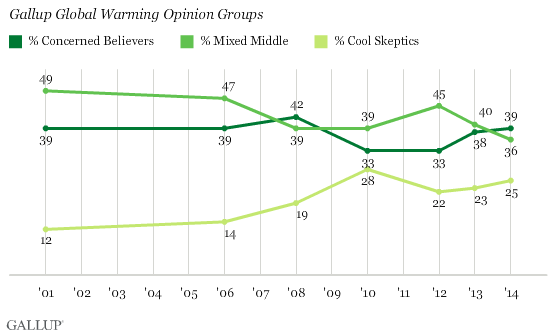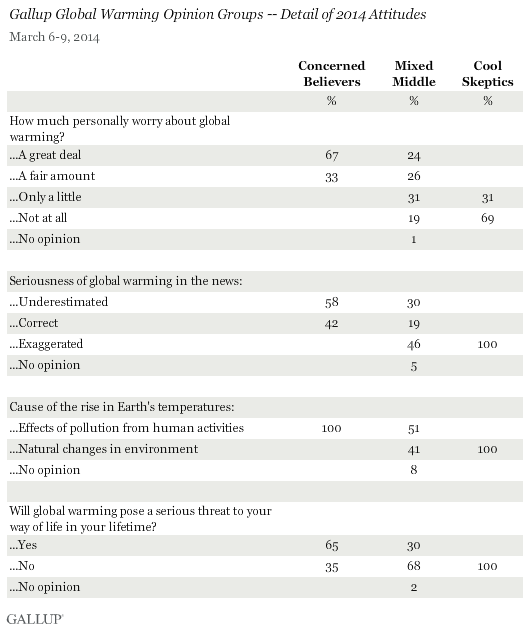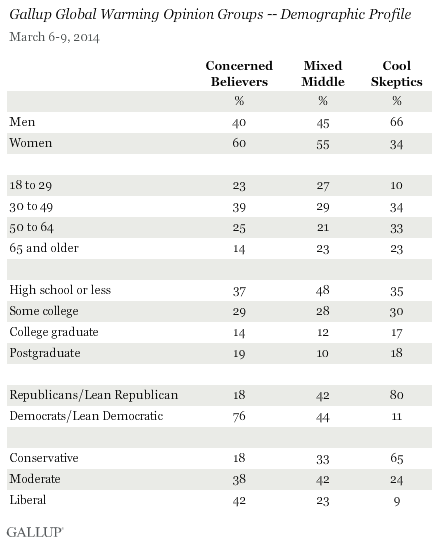PRINCETON, NJ -- Over the past decade, Americans have clustered into three broad groups on global warming. The largest, currently describing 39% of U.S. adults, are what can be termed "Concerned Believers" -- those who attribute global warming to human actions and are worried about it. This is followed by the "Mixed Middle," at 36%. And one in four Americans -- the "Cool Skeptics" -- are not worried about global warming much or at all.

The rate of Concerned Believers has varied some over the past decade and half, but is currently identical to the earliest estimate, from 2001. Over the same period of time, the ranks of Cool Skeptics have swelled, while the Mixed Middle -- once the largest group -- has declined modestly.
These groupings stem from a special "cluster" analysis of four questions that measure Americans' belief and concerns about human-induced global warming, all of which have been asked together on Gallup's annual Environment survey seven times since 2001. The latest results are from the March 6-9, 2014, Environment poll. However, the groupings derive from analysis of seven years of combined data.
Gallup has recently reported on a number of the individual trends included in the cluster analysis as part of its Climate Change series. This analysis provides a unique way of summarizing Americans' overall stance on global warming.
Perceived Cause of Global Warming Is Major Discriminator
Concerned Believers and Cool Skeptics are of entirely different mindsets when it comes to how much they worry about global warming. Concerned Believers say they worry "a great deal" or "fair amount" about the issue, while Cool Skeptics worry only "a little" or "not at all." Additionally, Concerned Believers think media reports about the issue are either correct or underestimated, while Cool Skeptics think they are exaggerated. And, most starkly, 100% of Concerned Believers say the rise in the Earth's temperature over the last century is due to the effects of pollution, while 100% of Cool Skeptics say it is due to natural changes in the environment. Finally, two-thirds of Concerned Believers believe global warming will pose a serious threat to their own way of life in the future, while 100% of Cool Skeptics disagree.
Americans in the Mixed Middle are individuals who hold a combination of views. For instance, some believe humans are the cause of the Earth's warming, but aren't worried about it. Others say global warming is a natural phenomenon, but that it will pose a serious risk in their lifetime. In one way or another, those in the Mixed Middle fail to line up with the orthodoxy on either side of the climate science issue.

Global Warming Clusters Differ by Gender, Age, and Politics
Concerned Believers are more likely to be women than men, 60% vs. 40%. Cool Skeptics skew even more strongly male -- 34% female vs. 66% male -- while the Mixed Middle is just slightly more female than the overall U.S. adult population.
Global warming groups are also highly differentiated by age and politics. The majority of Concerned Believers are younger than 50, and identify as or lean toward the Democratic Party, whereas the majority of Cool Skeptics are 50 years or older and are more likely to identify as or lean Republican. Similarly, the plurality of believers are self-described liberals, while two-thirds of skeptics call themselves conservative.
Notably, education is not a strong discriminator for the polarized groups, as a little over one-third of each group has no college experience, roughly 30% has some, and about one-third has a college degree or some advanced education. On the other hand, lack of college education is a distinguishing characteristic of the Mixed Middle, with nearly half this group reporting no more than a high school diploma, and less than one-quarter finishing college.

Bottom Line
Gallup's "cluster analysis" of Americans' views on four key global warming questions finds the public naturally breaking into three groups. The two at the extremes are near polar opposites of each other, disagreeing about the cause of global warming and how it's presented in the news, as well as having sharply different personal reactions to the issue.
The ranks of skeptics expanded between 2008 and 2010 due to the decline in concern about global warming as documented in Gallup's original trends. In particular, the percentage of Americans believing that global warming is caused by pollution from human activities dropped sharply in 2010. The same pattern has been seen with personal worry about global warming and the perception that the seriousness of the issue is exaggerated in the news. All of these findings are likely linked to the high profile "Climategate" controversy that emerged in late 2009, raising questions about the objectivity of some leading climate science researchers, as well as the legitimacy of some of their findings.
The broader, and perhaps more important, point is that even while skepticism rose -- causing a corresponding increase in the percentage of Americans who can be categorized as "Cool Skeptics" -- the percentage of "Concerned Believers" has recovered to pre-Climategate levels, while the Mixed Middle has dwindled. As with many issues in the past decade, Americans' views have grown more polarized.
For more Earth Day 2014 coverage, read this special guest commentary by Gallup Scholar for the Environment, Dr. Riley Dunlap, reviewing new Gallup data testing public reaction to the terms "global warming" versus "climate change."
Survey Methods
Results for this Gallup poll are based on telephone interviews conducted March 6-9, 2014, on with a random sample of 1,048 adults, aged 18 and older, living in all 50 U.S. states and the District of Columbia.
For results based on the total sample of national adults, the margin of sampling error is ±4 percentage points at the 95% confidence level.
Interviews are conducted with respondents on landline telephones and cellular phones, with interviews conducted in Spanish for respondents who are primarily Spanish-speaking. Each sample of national adults includes a minimum quota of 50% cellphone respondents and 50% landline respondents, with additional minimum quotas by time zone within region. Landline and cellular telephone numbers are selected using random-digit-dial methods. Landline respondents are chosen at random within each household on the basis of which member had the most recent birthday.
Samples are weighted to correct for unequal selection probability, nonresponse, and double coverage of landline and cell users in the two sampling frames. They are also weighted to match the national demographics of gender, age, race, Hispanic ethnicity, education, region, population density, and phone status (cellphone only/landline only/both, and cellphone mostly). Demographic weighting targets are based on the most recent Current Population Survey figures for the aged 18 and older U.S. population. Phone status targets are based on the most recent National Health Interview Survey. Population density targets are based on the most recent U.S. census. All reported margins of sampling error include the computed design effects for weighting.
In addition to sampling error, question wording and practical difficulties in conducting surveys can introduce error or bias into the findings of public opinion polls.
For more details on Gallup's polling methodology, visit www.gallup.com.
